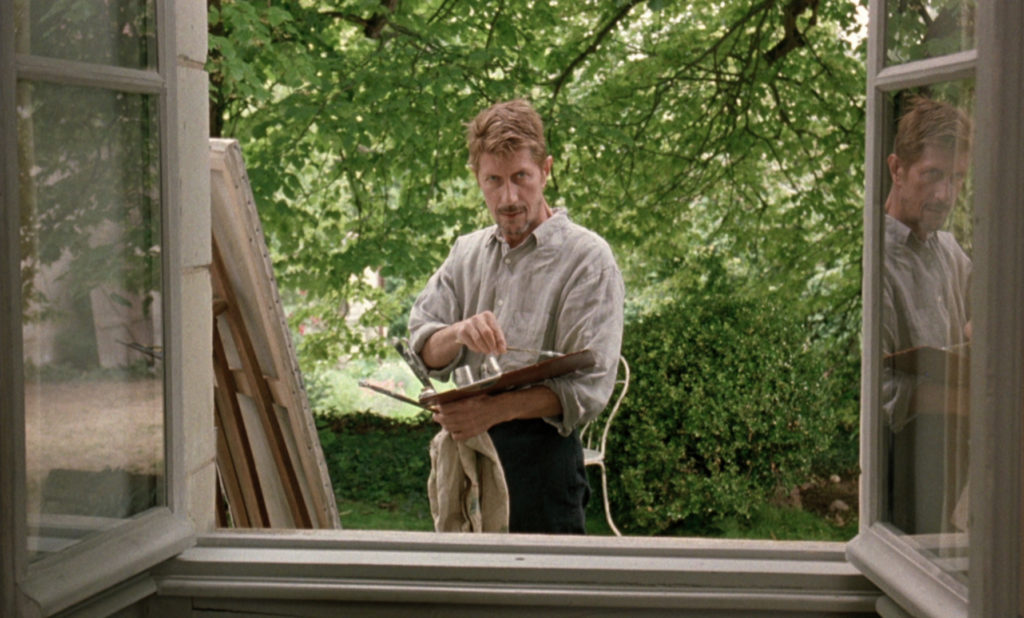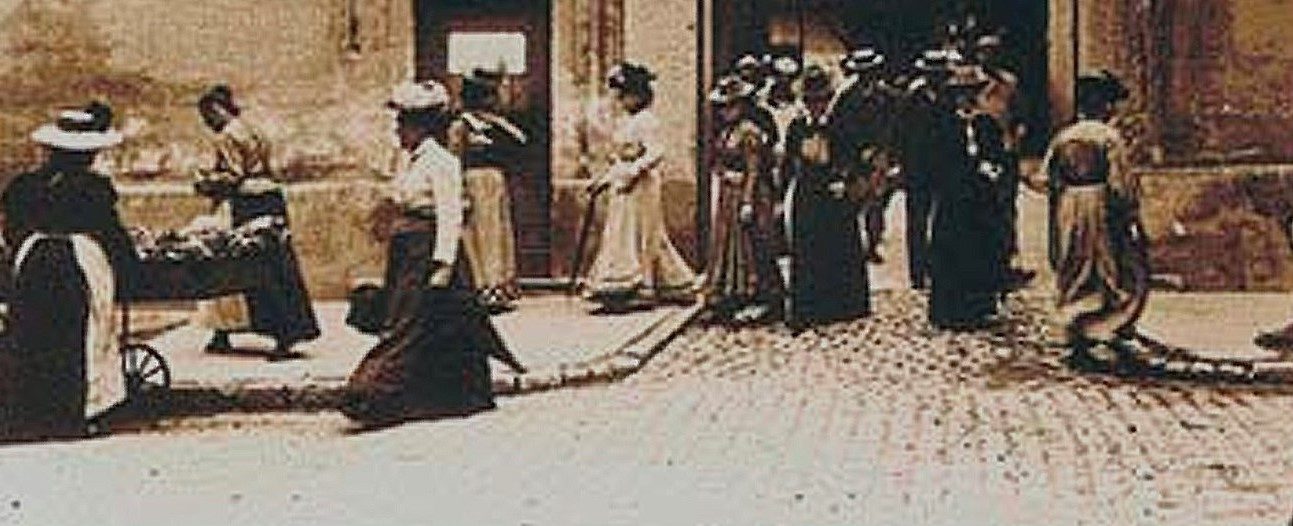France, 1991
Directed by Maurice Pialat
With Jacques Dutronc (Vincent Van Gogh), Gérard Séty (Dr. Gachet), Alexandra London (Marguerite Gachet), Bernard Le Coq (Théo Van Gogh), Corinne Bourdon (Jo), Elsa Zylberstein (Cathy), Jacques Vidal (Ravoux)

“Police” in 1985 or “Sous le soleil de Satan” in 1987 emphasized that if director Maurice Pialat was willing to tackle movie genres, it was only up to a point – once this point is reached, the film gets another direction and offers unexpected, fierce, moving sentiments, another, vivid and destabilizing view on the characters, against the audience’s expectations, it seems, but reflecting the aspiration, the passion of this cineaste of raw feelings and bitter confrontations grabbed by rough, intense shooting seeking the most candid, honest, immediate view of the characters, as were the cases in his 1972 poignant depiction of a couple struggling to stay together, “Nous ne vieillirons pas ensemble”, or his study in 1983 of a young woman asserting her identity, even if it means a conflict with a beloved father in 1972, “A nos amours”.
So if Pialat deals with a biopic, and one about a famous painter whose tragic life and unique talent can stoke speculation and fascination, it cannot be expected to be like Vincente Minnelli’s film of 1956, “Lust for Life”. Still, it is baffling.
It focuses on the last weeks of Vincent Van Gogh’s life, in Auvers-sur-Oise, near the French capital. It right away follows the painter without any hint at the context, and there will be no flashbacks, no extended talks about the past: this biopic does not care about expounding on a career or delving into a past conveniently shedding light on the present. And psychological explanations would not even be suggested: the film just puts one after another blocks of desultory but vibrant moments of life. The lead character may have strong feelings about the events, or may not, it is up to the audience to gather.
The whole collection of episodes seems organized in a two parts made distinct by the light, or the lack of it: a first part is basking in the broad, clear, sunny daylight of the spring in Auvers-sur-Oise (Van Gogh arrived in the village in the course of May 1890), a time when the painter seems relatively tranquil and in good spirits, while the second is wrapped in a much dimmer light, even reaching into darkness, as found in the apartments and cabarets of Paris but then extending to a village feeling less welcome and ultimately to the hotel room where death would come (on July, 29, 1890), a time thus of torment and despair.
Both parts starts with an arrival: Van Gogh getting off the train carrying him to Auvers-sur-Oise, and later knocking at the door of the Paris apartment of his brother, Théo Van Gogh, an initial motion setting off many others which still differ, depending on the section of the film. In the first part, the painter is always on the move, walking through the streets or the countryside paths, coming and going from his hotel, actually a restaurant and bar with a few rooms run by Mr. Ravaux, to the house of Dr. Gachet, a physician and art connoisseur and collector who Théo hoped could take care of Vincent, to the fields or the bank of the river. In the second part, it is more about getting excited, intoxicated, exhausted, though frantic gestures and motions, angrily pacing up and down an apartment, madly dancing and flirting in a cabaret, or rushing out of a train, before a bullet shot awkwardly abruptly makes any bustling, any painting, anything possible.
Both parts feature in the middle a fairly long episode of fun, recreation, entertainment. In the first part, it is a Sunday lunch at the Gachet house, with the doctor and his two children hosting not only the painter but also Théo and his wife Jo, carrying their newborn baby, a merry meeting that does not want to be brought to an end. Pranks and songs are used to linger at the lunch table, even the maids are invited to have a sit and to take part, then the group goes for a long walk near the river, then attending a guinguette, an open-air party organized by a restaurant or a bar owner to allow their customers to dance and have fun, then moving back, with couples getting formed to hold serious conversations, and then Vincent making the fool. In the second part, it is a long evening in a cabaret, with long dances, including a cancan, long moments spent by the patrons, including the painter and his brother, just staring at others, drinking, chatting, and above all flirting and even having sex.
The context of these parties cannot be more different: in the first case Van Gogh seems to have regain some balance, even if he still comes across as an unsympathetic, grumpy fellow, being curt or careless without a regret or a thought, while in the second case, he is incensed with his brother and his work, blaming Théo for not trying hard to sell his paintings while, in the same breath, moaning his output is mere rubbish. The film, to be sure, has always hinted at the gloomier part of the painter, the dark impulse that led his to hospital in the past: the first talk with Gachet includes a thorough physical examination, and later in the first part the montage out of the blue features shocking shots, in a dim light and terrible silence, of Van Gogh sitting completely dejected and then playing with a gun, directing it to the point between his eyebrows, a chilling vision that foretells his bloody belly late in the second part.
But it is still on a man enjoying life, or striving to, engaging with and having fun with various folks, who most often show up on the screen. These moments of joie de vivre, born out of a good lunch and good feelings, or on the contrary of the need to get invigorated and oblivious of the bad things. The film does not linger on the conventional images of the tormented, suffering artist – at one point Jo claims Van Gogh is not like that, fortunately. He is a fragile temperament, feels used up, but still fond of life.
Including women: the night at the cabaret (where a dozing Henri Toulouse-Lautrec is mockingly shot) is more than a sexual fantasy reflecting the supposed pleasure of the Parisian nights and taste for promiscuity and lightness of the French. It is the place where he meets again the young prostitute he seems to have an affair with for quite some time, Cathy, and where the daughter of Gachet tries to reach him, wretched and forlorn. If there has ever been something of a plot in this rambling film, it is the romance Marguerite Gachet yearns to have with the painter and does get, an implausible but charming love story that the painter does not know how to handle, even if he likes the girl, and that may not fit with real facts. But it allows the film to keep portraying the lead character as a man carried away by the stream of life, and accepting the little nice moments he can grasp, and that the camera captures in a riveting, powerful, truly direct and clear manner, even if dissatisfaction lurks in his heart. For Pialat, the point is to paint artlessly, effortlessly, and without any affectation, but with much sympathy, a complicated, delicate man who is an artist too. He gleefully rejects any cliché on the artist, any trope on madness and despair, any easy option to comfort and inform the audience. The restrained, nonchalant performance of Jacques Dutronc, with his skinny body, dreamy eyes, faint smile, quietly swaying from extrovert attitudes to deep ruminations, is a most precious asset (and the opposite of the remarkable work of Kirk Douglas in the 1956 film). Of course, the risk is that the audience may feel the narrative too slow, veering off course too easily, and ending in too shocking and puzzling manner.
The words “Van Gogh” appear on a striking extreme close-up on a palette knife spreading forcefully a coat of blue painting on a canvas, where the sky has been brushed vigorously. The title is misleading: the camera does not linger on Van Gogh actually painting, nor does it shot many conversations and reactions to the art. The topic is not overlooked, but just handled as an element of the daily life of the lead character: the film refuses to be a treatise, to attempt explanation or to bear witness to creativity. In fact, the key character of Gachet is affected, nearly ridiculous, and his thoughts on art feel hackneyed; conversely, the harsh, childish criticism of Marguerite is spontaneous, vibrant, compelling. True to himself, Pialat skillfully avoids serious and complacent discussion on the paintings of Van Gogh – and any exhibition: the works of Van Gogh are rarely put at the center of the composition, and in fact are not often shot (and of course, the film does not end with an endless display of his paintings, in stark opposite of the film of Vicente Minnelli). The trouble Van Gogh claims to have with his work, according to the screenplay, is that nobody in his family has ever understood it, and tried to support him, an accusation that hurts deeply Théo, and that may feel like a simplistic, selfish, smallish view on an astonishing, essential body of work. That sounds weak, and may stoke the sentiment the film just skims the topic. But then, it has been all along just about capturing a vitality on the verge of vanishing for ever, Pialat coming with a lust for life on his own, stubborn, rigorous, fiery terms.

